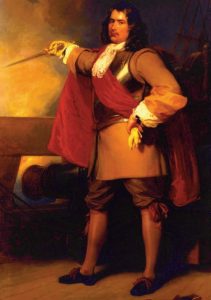
Bridgwater’s leading local history experts are in unanimous agreement that the town’s iconic statue of Admiral Robert Blake must remain in its place of honour on the Cornhill. Historians from across the political spectrum are agreed that Blake’s career is a source of pride for the town, and that his only involvement in slavery was in freeing them. Last Sunday, the statue of Bristol Slave Trader Edward Colston was thrown in the docks by Black Lives Matters protestors. Today its been fished out by the council and will be put on display in a museum surrounded by the placards. Probably where it should have been in the first place. Shortly afterwards the spotlight shone on all the monuments of Britain’s Slave Trading past and a ‘topple list’ was drawn up including such historical figures as Nelson, Drake and Cromwell. Surprisingly on this list was Bridgwater’s own Admiral Robert Blake. Surely some mistake. Town Council Leader and Historian Brian Smedley who researched and published the story of Bridgwater being the first town to petition against the Slave Trade, immediately summoned a (socially distanced) (in some cases by hundreds of miles) Bridgwater Convention of Historians to investigate the allegations.
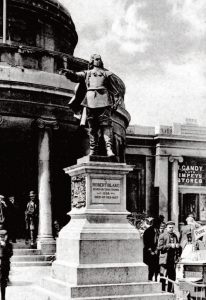
The historians all agreed that Robert Blake, like Bridgwater, was (usually) on the right side of history.
Robert Blake died in 1657 after a long parliamentary and military career both on land in the English Civil War and at sea afterwards. He was the towns MP and a Puritan. Becoming commander of the Republican navy he later defeated the French, the Dutch and the Spanish navies plus he liberated the Channel islands from the remaining Royalists and then freed the slaves from the Barbary pirates of North Africa. When he died, he left money to the people of Bridgwater, his family and to his servants. He never married.
On the Right Side of History
Brian Smedley says “Bridgwater people should be proud of their history. We have a great radical, reforming and even revolutionary spirit here. We’ve almost always been on the right side of history. In the Civil war of the 1640’s it was Parliamentarians like Blake that helped to rid the country of a despotic feudal monarchy and it was the freedoms unleased during the English Republic that sowed the seeds of radical free thought and actually led to the abolitionist movement. It was fronted by Dissenters, by Levellers and especially by Quakers, who were Whigs, Liberals, Radicals and later Socialists. It was that idealism that led to the people rising up at the Battle of Sedgemoor in 1685, whereafter, many local people were punished by transportation as slaves to the West Indies and it was exactly 100 years after that date that Bridgwater became the first town to petition Parliament for the ending of the Slave Trade.
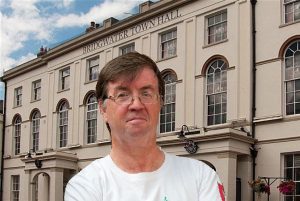
Blake was on the right side of that history. It was after Blake and the Republic that the restored Monarchy jumped feet first into the slave trade when it set up the Royal Africa Company. That’s Charles 11 and his Brother James 11-who was the persecutor of Bridgwater people after Sedgemoor and the last Monarch to set foot in this town for 300 years , contenting himself with hanging drawing and quartering the Bridgwater rebels and then transporting the rest. And it was that same R.A.C that Edward Colston was part of as a Tory MP and an open slave trader and who quite rightly deserved a symbolic temporary dunking.”
Not a Slaver
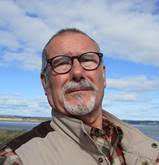
Popular speaker on local history Chris Sidaway says “Robert Blake was not a slaver but a Christian gentleman who had a black man-servant (which was prevalent at the time) . He had 3 servants (not slaves) two white and one black. In his Will, the white servants (James Knowles and Nicholas Bartlett) received £10 each whilst his black servant Domingo received £50. There are of course far guiltier parties with regard to the Slave Trade -Drake and Hawkins were sponsored on their slavery exploits by Queen Elizabeth 1 who profited enormously from the returns: King Charles 2 was an enthusiastic investor in slavery and most C17th aristocracy benefited (Royal Adventurers into Africa); as did the Church of England whose company name The Association was branded into the foreheads of slaves; Most of the C18th. Merchant wealth was underpinned by slavery – cotton, sugar, cocoa, coffee and tobacco. But not in Bridgwater, where the non-conformist merchants were against it!”
Celebrated as a ‘Local Hero’
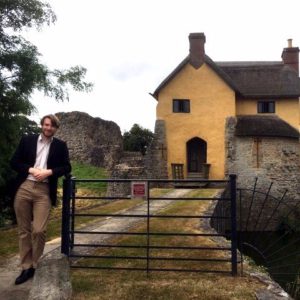
Bridgwater born historian Miles Kerr Petersen says “As to Blake, I wouldn’t personally consider there to be any good reason at all for his statue in Bridgwater to be even considered for removal. It was raised partly as a local celebration of civic pride and part of a wider celebration of the town’s connections to the sea. I’d say that our Blake is celebrated as a local hero because of his qualities and his achievements as an individual, not necessarily as an expression of any institution his reforms led to create. As to Blake the person, I think there’s little that can be leveled against him – unless you’re a hardcore Royalist of course! He was obliquely involved with Cromwell’s suppression of Ireland, but Blake’s role was to bob around outside Kinsale waiting for Prince Rupert, and Blake explicitly turned down a promotion to become a Major General on land for Cromwell, who he had ideological differences with anyway. Likewise, Blake was involved in an overall strategy that seized Jamaica, but he was again bobbing around outside Cadiz while that happened, and was not the author of said strategy. Personally, as a boy growing up in Bridgwater, although I only vaguely knew who Blake was, I always took the statue as a wonderful symbol that *even* if you came from Bridgwater, you could still be a success and change the world. And Blake had good qualities worth celebrating – he fought against what he saw as the tyranny of a bad king, his military successes were a direct result of hard graft in supply and dedication in leadership, and he specifically went out of his way in North Africa to address the problem of Barbary raids on England far beyond the brief he was given. He was also unafraid to speak in gruff tones to the crowned heads of Europe.”
Opportunity to Learn More about the Fascinating History

Matthew Smith, Bridgwater College history lecturer, added “It is only right that society has a say over which monuments are appropriate representations of our social values. However, It is important to remember that such monuments reflect the value of the times in which they were erected. In the case of John Cassidy’s statue of Edward Colston, it was created in 1895 to commemorate Colston’s ‘philanthropy’. Clearly, attitudes towards race were far less progressive in the Victorian era and, personally, I have long been uncomfortable about the “whitewashing” of Colston’s involvement in the Atlantic slave trade. Regarding Admiral Blake, I am not aware of any reason as to why the community would consider removing his statue. Among Blake’s many achievements as ‘Father of the Navy’ were the introduction of the first ever set of naval rules and regulations, as well as new techniques to conduct blockades and landings. Indeed, even Nelson would go on to remark, “I do not reckon myself equal to Blake”. Ultimately, it is up to the citizens of Bridgwater to decide the fate of their statue.
I hope they use it as an opportunity to learn more about the fascinating history of a local boy made good.”
Committed Parliamentarian
Bridgwater’s key heritage outlet for historical study is the Admiral Blake Museum which is situated in the house of his birth.

Blake Museum historian Tony Woolrich said “Blake was a member of a Company trading in North Africa and the Mediterranean as a young man. He was never a slave trader”.
While curator Mike Searle , who has set up a very popular Facebook history site during the Covid crisis, added “I think any attempt to have Blake’s statue removed would receive great hostility from the folk of Bridgwater. Just look at the time the statue was relocated and the anger that caused, and which still resonates today.”
Author Roger Evans, Bridgwater’s leading expert on Robert Blake, said “I would find any attempt to denigrate the name of Admiral Blake as offensive. He was a committed parliamentarian who gave his life in the service of his country. To even suggest that his statue should be removed would offend the vast majority of sensibly–minded Bridgwater citizens who respect him as our best-known local hero.”
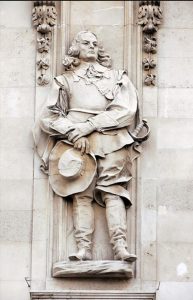
Cllr Smedley adds “When Robert Blake died he was so venerated by the people that he was given a state funeral but when the Royalists regained power 3 years later the King ordered his remains to be dug up and thrown into an unmarked grave. I think that shows which side of history our Robert Blake was on!”
The Goldsmiths Blake
The Statue of Robert Blake at Goldsmiths (left) in London appeared on the ‘topple list’ but the text only referred to his involvement with Oliver Cromwell. During the 1650’s England was a Republic and Cromwell was ‘Lord Protector’. Cromwell invaded Ireland where his reputation continues to this day as a symbol of English oppression (to the Catholics). He transported Irish slaves to the West Indies. Cromwell also invaded Jamaica and fought the Spanish there. Blake’s role, as described by Miles KP above was peripheral.

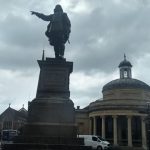
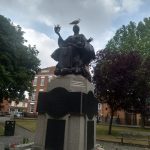
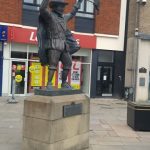
Well done Bridgwater! Any idea where I can find a list of all 612 men who were transported anyone?
is it possible to have a photo of the goldsmith’s statue?
I will add a Goldsmith Blake to the gallery
Who is responsible for the “topple list”? Nobody seems to know. This statue was raised by Bridgwater citizens and has nothing to do with anyone else. There is no need for anyone in Bridgwater to justify this statue. I trust that the police will take immediate action if anyone tries to deface or damage the statue.
Victoria, the so called ‘topple list’ comes from a web site which allows people to nominate statues. That’s a bit random in itself isn’t it? Blake was on that list. Not the Bridgwater statue but a statue of him at Goldsmiths in London. I think it’s out job to defend him and also to warn against the randomness of self appointed list makers.
Very pleased a wise decision What about a statute for Breaker Morant?
Well, I’d argue the jury’s no longer out on that one…..https://www.westoverward.co.uk/breaker-morant-hero-or-villain/
Brian, could you please advise me from where this idea to remove/cover or whatever the Blake statue came from. Thank you.
Bernice, Blake is listed on the ‘topple the racists’ website and while this refers to the Blake statue at Goldsmiths, it’s still the same Blake so we thought it best to draw a line in the sand and stick up for our boy.
Thank you. I think the level of resistance from our part of the world will be something to be reckoned with should those idiots who drum up this kind of stuff even ‘think’ about such action!
If people don’t like the statues. They can go live in another Country. Bugger them
Absolutely agree. Blake’s statue must stay. Interesting that the West Indies WHITE slaves have been ignored! Hundreds of Monmouth’s Western Rising Rebels transported 1685.
Timely and stunningly percipient explanation. Thank you. I am really pleased to hear all these knowledgeable and authoritative statements from people whose opinion and legitimacy are so well-respected.